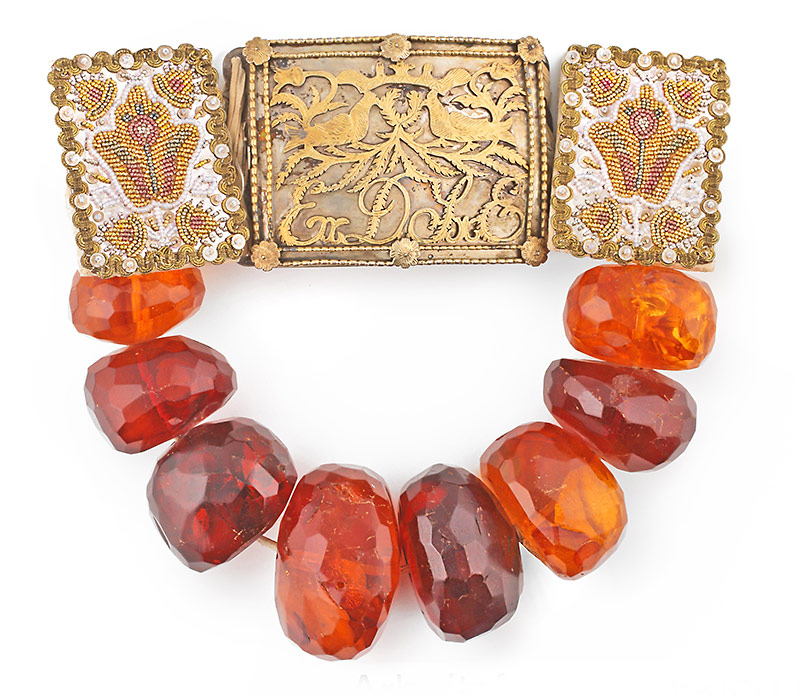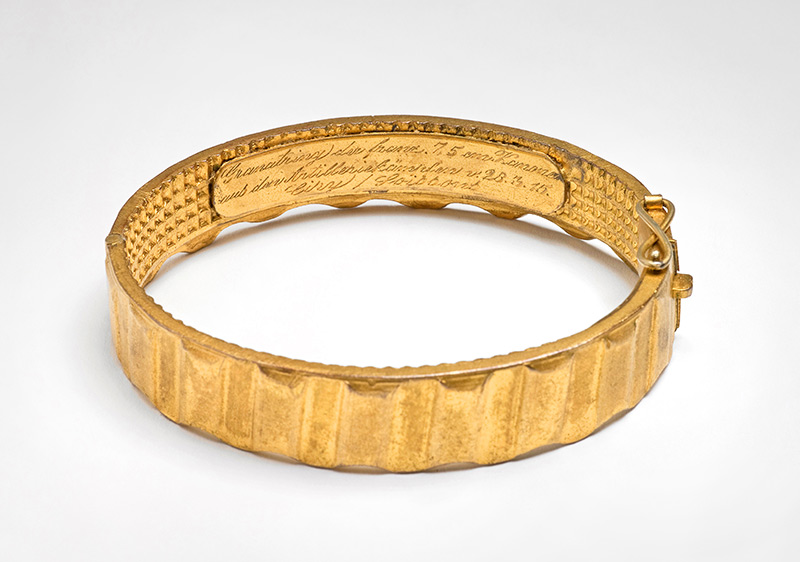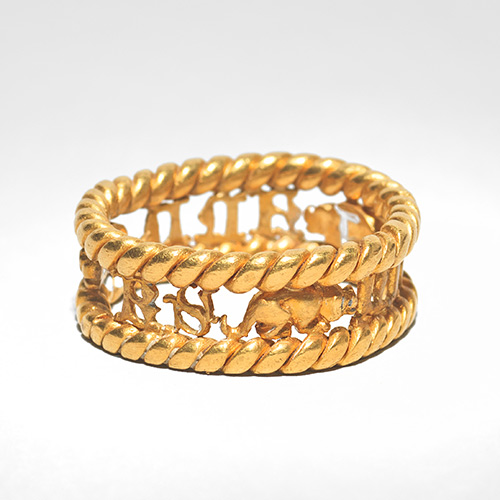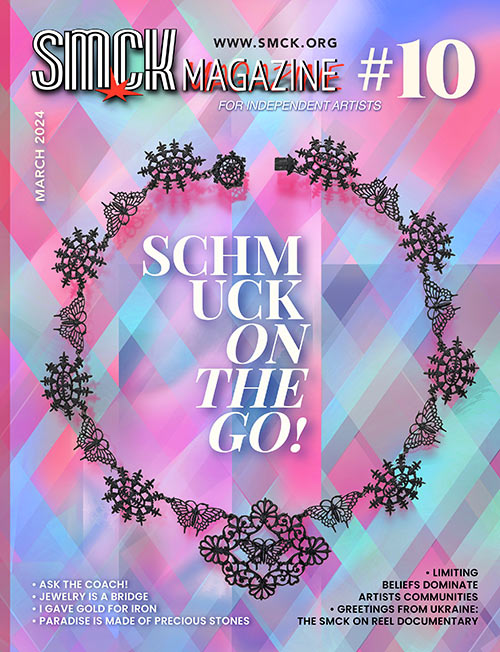WE HAVE LOST OUR LONG TERM RELATION TO JEWELRY
DR. ADELHEID RASCHE, CURATOR OF THE GERMANISCHES NATIONALMUSEUM'S JEWELRY COLLECTIONS, ON HOW ORNAMENTS ENRICH OUR UNDERSTANDING OF SOCIETY.
Interview by Loukia Richards
 Wedding chain from the region of Lipper, 1880s. Amber faceted, silver, partially goldplated; metal lath, sequins, glass bead embroidery. © Germanisches Nationalmuseum Nürnberg.
Wedding chain from the region of Lipper, 1880s. Amber faceted, silver, partially goldplated; metal lath, sequins, glass bead embroidery. © Germanisches Nationalmuseum Nürnberg.
Founded in 1852, the Germanisches Nationalmuseum (GNM) holdings span the Stone Age and earliest Germanic cultures to the present day. Its collection of textiles, clothing, and jewelry – a distinctive category – has more than 25,000 objects.
Dr. Adelheid Rasche is the curator of urban and rural jewelry, which features items dating from the Middle Ages and Early Modern times to our days. The collection focuses on jewelry from German-speaking regions but also includes items that had originated elsewhere but were widely worn in German-speaking areas.
Dr. Adelheid Rasche explains how the German national museum's jewelry collections enrich our understanding of history and society – and fuel our quest for slower jewelry.
SMCK: Tell us the story behind your favorite objects from the GNM collection.
ADELHEID RASCHE: My favorite object changes every day! However, I have chosen the following three for this interview: The bangle made of a grenade pull ring from 1915 (see image 02) reminds us of the World War One battles in northern France. The museum acquired it from a private estate; the son of the family had fallen in this battlefield. Through this bangle, his young fiancée could indirectly wear on her body a small symbol of her dead husband-to-be.
By contrast, the wedding chain from the region of Lipper that was made in the 1880s with amber facets, pearl embroidery, and partly gilded lock (see image 01) tells the story of power and wealth. The bride's dress was so luxurious that the chain was hardly noticed!
For me, this very elegant bridal ring from the 15th century made of golden wire and gold sheet (see image 03) with three dogs as symbols of faith and the interrupted text "NIE - AND(E)RS" (never differ(e)nt) would still be a good design for contemporary wedding rings.
 Bangle made from a grenade pull ring, 1915. Copper, gold-plated. © Germanisches Nationalmuseum Nürnberg. Photo: Monika Runge.
Bangle made from a grenade pull ring, 1915. Copper, gold-plated. © Germanisches Nationalmuseum Nürnberg. Photo: Monika Runge.
SMCK: What materials and techniques are implicit when speaking of historical jewelry?
ADELHEID RASCHE: When we talk about classical jewelry – parures, rings, brooches, garment jewelry – precious metals and precious stones set by using traditional goldsmithing techniques are in the foreground. In premodern times, jewelry was the sole property of the bride and not part of the dowry so that she could make use of the jewelry's material value in case of emergency.
In the case of adorning accessories, such as key rings, melted bronze was used; for belts one used precious and non-precious metals, often in combination with textiles. The same principle applies with adorning head coverings. I think of bridal crowns or of the famous "Flinderhaube" (headgear with tinsels) from Nuremberg; in the latter case, metal has been mixed with textile. Bridal crowns were ornamented with glass pearls, tinsels, and bouillon wire. Rural jewelry – what earlier has been called peasants' jewelry or folk dress jewelry – is mostly made of silver that has been partly gilded. Silver filigree was also a common technique.
Depending on the region, jewelry stones, often made of ground glass, were added.

Bridal ring, first half of the fifteenth century. Twisted gold wire, sheet gold. © Germanisches Nationalmuseum Nürnberg. Photo: Georg Janßen.
SMCK: What do the jewelry pieces in the museum's collection tell us about the history of Nuremberg and the region?
ADELHEID RASCHE: We must always keep in mind that only a tiny part of jewelry made in past centuries still exists today, and through this fact the picture we have of the real use of jewelry in earlier times is limited.
What was preserved were mostly the materially-precious pieces or jewelry with a memorial function. Of course, there is also jewelry property that has been preserved at random. Altogether, the information on individual pieces is unfortunately not always preserved: who made them and for what occasion, who wore them, what did they mean for the wearer – male or female – or why they have been preserved.
The emphasis of our museum collection is not on objects from Nuremberg or the region of Franconia because GNM is not a city museum. Nevertheless, some of the big patrician families of Nuremberg (Merkel, von Praun, von Scheurl, Tucher,) have decided to give a part of their historical jewelry to our collection as permanent loan. Apart from that, we own two of the famous Nuremberg charms chains with so-called health stones, and two similar bracelets. For many centuries the upper class of Nuremberg was well off, internationally well-connected, and showed this cosmopolitan alignment also in dress and jewelry that would reflect its standing.
Fast jewelry
At the time it was made, every piece of jewelry was 'contemporary'. This is why I would not differentiate between historical and contemporary jewelry.
Jewelry has always been an ornamental accessory that partly had a function (golden crown, closing of garment, cufflinks, watch chain, etc.), had always been charged with ideas, and with huge symbolic power. In my opinion, on this point nothing has changed to date. Everybody who wears jewelry (or does not wear jewelry) makes a statement.
The variety of materials is today obviously greater and the price spectrum is broader. What we have somehow lost today is our long-term relationship to jewelry. As in fashion, the trend goes in the direction of fast jewelry.
It would be interesting to see whether in a few decades today's young people would pass down to their heirs a jewelry box like our ancestors did.
(Dr. Adelheid Rasche)
LINKS:
www.gnm.de/collections
instagram: @germanisches_nationalmuseum







